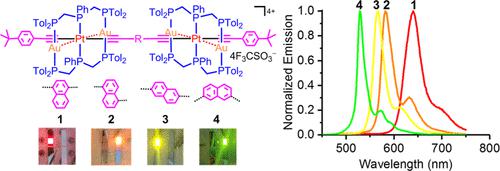当前位置:
X-MOL 学术
›
ACS Appl. Electron. Mater.
›
论文详情
Our official English website, www.x-mol.net, welcomes your feedback! (Note: you will need to create a separate account there.)
Modulating Narrow-Band Phosphorescence of Pt2Au4 Cluster Complexes by Differently Positioned Bis(acetylide)-Naphthalene Linkers
ACS Applied Electronic Materials ( IF 4.3 ) Pub Date : 2023-02-08 , DOI: 10.1021/acsaelm.2c01514 Da-Sheng Zheng 1, 2 , Jin-Yun Wang 1 , Lin-Xi Shi 1 , Zhong-Ning Chen 1, 2, 3
ACS Applied Electronic Materials ( IF 4.3 ) Pub Date : 2023-02-08 , DOI: 10.1021/acsaelm.2c01514 Da-Sheng Zheng 1, 2 , Jin-Yun Wang 1 , Lin-Xi Shi 1 , Zhong-Ning Chen 1, 2, 3
Affiliation

|
To modulate phosphorescent characteristics of Pt2Au4 complexes with differently positioned bis(acetylide)naphthalene as a bridging ligand, four isomeric Pt2Au4 complexes (1–4) linked by 1,4-bis(acetylide)naphthalene (1), 1,5-bis(acetylide)naphthalene (2), 2,6-bis(acetylide)naphthalene (3), and 2,7-bis(acetylide)naphthalene (4) are elaborately designed and prepared. The Pt2Au4 complexes are strongly phosphorescent with the quantum yields as high as 52% in CH2Cl2 solutions, in strikingly contrast to weak phosphorescence of bis(acetylide)naphthalene-linked Pt2 precursors. After the formation of Pt2Au4 cluster structures, the increased molecular rigidity dramatically suppresses nonradiative relaxation, which becomes less competitive in contrast to the radiative relaxation of the emitting state, thus resulting in a remarkable enhancement of the quantum yields. Depending on the positions of bis(acetylide) groups attached to naphthalene rings, the phosphorescence of Pt2Au4 isomers in CH2Cl2 solutions follows 1 (640 nm) → 2 (582 nm) → 3 (567 nm) → 4 (529 nm) to show progressive blue shifts. As demonstrated by photophysical and theoretical studies, vibronic-structured narrow-band emission with a full width at half maxima (fwhm) of 707–1073 cm–1 is primarily ascribable to ligand-centered triplet states localized at bis(acetylide)naphthalenes, which is dramatically activated upon the formation of the Pt2Au4 cluster because the energy harvested by two PtAu2 cluster moieties is effectively transferred to bridging bis(acetylide)naphthalene. Taking advantage of Pt2Au4 complexes 1–4 as phosphorescent emitters, solution-processed OLEDs achieve narrow-band electroluminescence with peak external quantum efficiency of 11.0% for red-emitting complex 1 (fwhm = 45 nm or 1058 cm–1), 9.4% for orange-emitting complex 2 (fwhm = 33 nm or 960 cm–1), 13.7% for yellow-emitting complex 3 (fwhm = 33 nm or 1029 cm–1), and 15.2% for green-emitting complex 4 (fwhm = 24 nm or 848 cm–1).
中文翻译:

通过不同位置的双(乙炔)-萘接头调节 Pt2Au4 簇配合物的窄带磷光
为了调节具有不同位置的双(乙炔)萘作为桥接配体的 Pt 2 Au 4 配合物的磷光特性,四个异构 Pt 2 Au 4配合物( 1 – 4 )通过 1,4-双(乙炔)萘(1)连接,精心设计制备了1,5-双(乙炔)萘( 2 )、2,6-双(乙炔)萘( 3 )和2,7-双(乙炔)萘( 4 )。Pt 2 Au 4配合物具有强烈的磷光性,在 CH 2 Cl 2中的量子产率高达 52%解决方案,与双(乙炔)萘连接的 Pt 2前体的弱磷光形成鲜明对比。Pt 2 Au 4簇结构形成后,增加的分子刚性显着抑制了非辐射弛豫,与发射态的辐射弛豫相比,非辐射弛豫的竞争性降低,从而导致量子产率显着提高。根据与萘环相连的双(乙炔)基团的位置,Pt 2 Au 4异构体在 CH 2 Cl 2溶液中的磷光遵循1 (640 nm) → 2 (582 nm) → 3(567 nm) → 4 (529 nm) 显示渐进蓝移。正如光物理和理论研究所证明的那样,半峰全宽 (fwhm) 为 707–1073 cm –1的电子振动结构窄带发射主要归因于位于双(乙炔)萘上的以配体为中心的三重态,这在形成 Pt 2 Au 4簇时被显着激活,因为由两个 PtAu 2簇部分收集的能量被有效地转移到桥接双(乙炔)萘。利用 Pt 2 Au 4配合物1 – 4作为磷光发射体,溶液处理的 OLED 实现了窄带电致发光,红色复合物1(fwhm = 45 nm 或 1058 cm –1)的峰值外量子效率为 11.0%,橙色复合物2为 9.4% (fwhm = 33 nm 或 960 cm –1),黄色发射复合物3(fwhm = 33 nm 或 1029 cm –1)为 13.7%,绿色发射复合物4(fwhm = 24 nm 或 848 cm –1)为 15.2%。
更新日期:2023-02-08
中文翻译:

通过不同位置的双(乙炔)-萘接头调节 Pt2Au4 簇配合物的窄带磷光
为了调节具有不同位置的双(乙炔)萘作为桥接配体的 Pt 2 Au 4 配合物的磷光特性,四个异构 Pt 2 Au 4配合物( 1 – 4 )通过 1,4-双(乙炔)萘(1)连接,精心设计制备了1,5-双(乙炔)萘( 2 )、2,6-双(乙炔)萘( 3 )和2,7-双(乙炔)萘( 4 )。Pt 2 Au 4配合物具有强烈的磷光性,在 CH 2 Cl 2中的量子产率高达 52%解决方案,与双(乙炔)萘连接的 Pt 2前体的弱磷光形成鲜明对比。Pt 2 Au 4簇结构形成后,增加的分子刚性显着抑制了非辐射弛豫,与发射态的辐射弛豫相比,非辐射弛豫的竞争性降低,从而导致量子产率显着提高。根据与萘环相连的双(乙炔)基团的位置,Pt 2 Au 4异构体在 CH 2 Cl 2溶液中的磷光遵循1 (640 nm) → 2 (582 nm) → 3(567 nm) → 4 (529 nm) 显示渐进蓝移。正如光物理和理论研究所证明的那样,半峰全宽 (fwhm) 为 707–1073 cm –1的电子振动结构窄带发射主要归因于位于双(乙炔)萘上的以配体为中心的三重态,这在形成 Pt 2 Au 4簇时被显着激活,因为由两个 PtAu 2簇部分收集的能量被有效地转移到桥接双(乙炔)萘。利用 Pt 2 Au 4配合物1 – 4作为磷光发射体,溶液处理的 OLED 实现了窄带电致发光,红色复合物1(fwhm = 45 nm 或 1058 cm –1)的峰值外量子效率为 11.0%,橙色复合物2为 9.4% (fwhm = 33 nm 或 960 cm –1),黄色发射复合物3(fwhm = 33 nm 或 1029 cm –1)为 13.7%,绿色发射复合物4(fwhm = 24 nm 或 848 cm –1)为 15.2%。















































 京公网安备 11010802027423号
京公网安备 11010802027423号